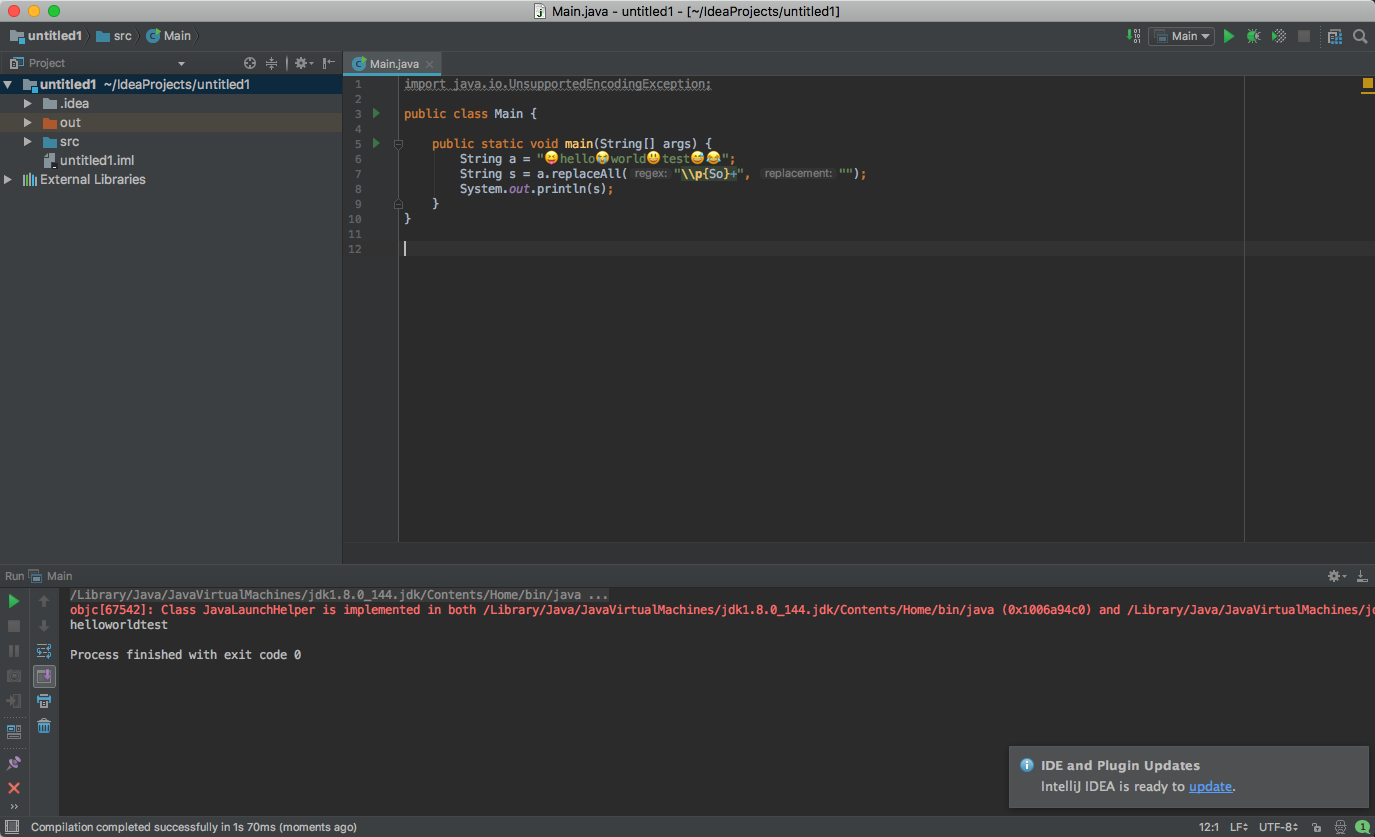Here in 2024 with Java 21, it's much simpler than it used to be back in 2014 when the answer below was written. You can use the Unicode character category IsEmoji, see Mahozad's answer for details!
the pdf that you just mentioned says Range: 1F300–1F5FF for Miscellaneous Symbols and Pictographs. So lets say I want to capture any character lying within this range. Now what to do?
Okay, but I will just note that the emoji in your question are outside that range! :-)
The fact that these are above 0xFFFF complicates things, because Java strings store UTF-16. So we can't just use one simple character class for it. We're going to have surrogate pairs. (More: http://www.unicode.org/faq/utf_bom.html)
U+1F300 in UTF-16 ends up being the pair \uD83C\uDF00; U+1F5FF ends up being \uD83D\uDDFF. Note that the first character went up, we cross at least one boundary. So we have to know what ranges of surrogate pairs we're looking for.
Not being steeped in knowledge about the inner workings of UTF-16, I wrote a program to find out (source at the end — I'd double-check it if I were you, rather than trusting me). It tells me we're looking for \uD83C followed by anything in the range \uDF00-\uDFFF (inclusive), or \uD83D followed by anything in the range \uDC00-\uDDFF (inclusive).
So armed with that knowledge, in theory we could now write a pattern:
// This is wrong, keep reading
Pattern p = Pattern.compile("(?:\uD83C[\uDF00-\uDFFF])|(?:\uD83D[\uDC00-\uDDFF])");
That's an alternation of two non-capturing groups, the first group for the pairs starting with \uD83C, and the second group for the pairs starting with \uD83D.
But that fails (doesn't find anything). I'm fairly sure it's because we're trying to specify half of a surrogate pair in various places:
Pattern p = Pattern.compile("(?:\uD83C[\uDF00-\uDFFF])|(?:\uD83D[\uDC00-\uDDFF])");
// Half of a pair --------------^------^------^-----------^------^------^
We can't just split up surrogate pairs like that, they're called surrogate pairs for a reason. :-)
Consequently, I don't think we can use regular expressions (or indeed, any string-based approach) for this at all. I think we have to search through char arrays.
char arrays hold UTF-16 values, so we can find those half-pairs in the data if we look for it the hard way:
String s = new StringBuilder()
.append("Thats a nice joke ")
.appendCodePoint(0x1F606)
.appendCodePoint(0x1F606)
.appendCodePoint(0x1F606)
.append(" ")
.appendCodePoint(0x1F61B)
.toString();
char[] chars = s.toCharArray();
int index;
char ch1;
char ch2;
index = 0;
while (index < chars.length - 1) { // -1 because we're looking for two-char-long things
ch1 = chars[index];
if ((int)ch1 == 0xD83C) {
ch2 = chars[index+1];
if ((int)ch2 >= 0xDF00 && (int)ch2 <= 0xDFFF) {
System.out.println("Found emoji at index " + index);
index += 2;
continue;
}
}
else if ((int)ch1 == 0xD83D) {
ch2 = chars[index+1];
if ((int)ch2 >= 0xDC00 && (int)ch2 <= 0xDDFF) {
System.out.println("Found emoji at index " + index);
index += 2;
continue;
}
}
++index;
}
Obviously that's just debug-level code, but it does the job. (In your given string, with its emoji, of course it won't find anything as they're outside the range. But if you change the upper bound on the second pair to 0xDEFF instead of 0xDDFF, it will. No idea if that would also include non-emojis, though.)
Source of my program to find out what the surrogate ranges were:
public class FindRanges {
public static void main(String[] args) {
char last0 = '\0';
char last1 = '\0';
for (int x = 0x1F300; x <= 0x1F5FF; ++x) {
char[] chars = new StringBuilder().appendCodePoint(x).toString().toCharArray();
if (chars[0] != last0) {
if (last0 != '\0') {
System.out.println("-\\u" + Integer.toHexString((int)last1).toUpperCase());
}
System.out.print("\\u" + Integer.toHexString((int)chars[0]).toUpperCase() + " \\u" + Integer.toHexString((int)chars[1]).toUpperCase());
last0 = chars[0];
}
last1 = chars[1];
}
if (last0 != '\0') {
System.out.println("-\\u" + Integer.toHexString((int)last1).toUpperCase());
}
}
}
Output:
\uD83C \uDF00-\uDFFF
\uD83D \uDC00-\uDDFF


<U+1F606>string is specific toless- also, your solution idea would also capture just about any other unicode character. The only real solution would be to have a list of all unicode code points corresponding to emojis. – OstrowskiRange: 1F300–1F5FFforMiscellaneous Symbols and Pictographs. So lets say I want to capture any character lying within this range. Now what to do? – Krasnoyarsk